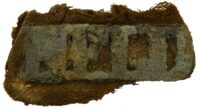 After three years of investigation, the Canadian military has identified the remains of a World War I soldier who was killed in action in 1917. He was Private John Lambert of St. John’s, Newfoundland who was barely 16 years old when he lied about his age to enlist in 1916. His remains and those of three still-unidentified British soldiers were discovered in April 2016 during an archaeological survey near the town of Langemark, Belgium.
After three years of investigation, the Canadian military has identified the remains of a World War I soldier who was killed in action in 1917. He was Private John Lambert of St. John’s, Newfoundland who was barely 16 years old when he lied about his age to enlist in 1916. His remains and those of three still-unidentified British soldiers were discovered in April 2016 during an archaeological survey near the town of Langemark, Belgium.
Born on July 10th, 1900, Lambert enlisted on August 14th, 1916. He claimed to be 18 years and three months old, which means he lied about his birth date as well as the year. Two weeks later he was on his way to Scotland to join the 2nd Battalion of The Newfoundland Regiment. There he and his comrades were trained before being sent to the Western Front. He joined the 1st Battalion in the field in June 1917. In August, Lambert’s division was deployed to attack the German lines north of Ypres. The advance was successful and the 29th Division took all of its objects, but John Lambert paid the ultimate price. He died of his wounds received during the advance, dubbed the Battle of Langemarck, on August 16th. He was 17 years and six days old.
He was recorded as killed in action and his family notified, but in the confusion of war, his grave site was lost.
The war diary of the 88th Brigade mentions that a ‘Field Ambulance Relay Post’ was located near Tuffs Farm. This relay post was most likely located within 100 meters of the location where Private Lambert was recovered in 2016. It is believed that he and the other soldiers found with him were buried near this ‘Relay Post’ and for unknown reasons their remains were not found and recovered following the war.
 When the remains of the four soldiers were discovered in 2016, one of the artifacts found in the grave was the shoulder title of The Newfoundland Regiment. Armed with this key clue, the Canadian Armed Forces’ Casualty Identification Program set to discovering the identity of the soldier.
When the remains of the four soldiers were discovered in 2016, one of the artifacts found in the grave was the shoulder title of The Newfoundland Regiment. Armed with this key clue, the Canadian Armed Forces’ Casualty Identification Program set to discovering the identity of the soldier.
Only 16 Newfoundlanders were listed as missing from World War I, which helpfully limited the number of possibilities, but the process was challenging nonetheless. Osteological analysis and DNA retrieved from his bones revealed his age and height. Here John Lambert’s century-old lies put a spanner in the works, because the army’s records for his age obviously did not match the biological evidence.
Extensive historical and genealogical research was able to locate descendants of 13 of the 16 missing Newfoundlanders, and Patricia Egan, Lambert’s 90-year-old niece, provided her DNA to test against his. It was a match.
St. John’s resident Shirlene Murphy, [Egan’s daughter,] said the family kept his memory alive through the years.
“The family dearly loved him,” Murphy said in an interview Tuesday, noting that Lambert was her grandmother’s brother. “He was always talked about. There’s pictures of him in everybody’s house.”
Everyone in the family referred to him as “Uncle Jack.” […]
A padre and the commanding officer of the Royal Newfoundland Regiment officially delivered the news to Eagan on Friday that her uncle had been identified.
“She’s just amazed,” said Murphy, referring to her mother. “The first thing she thought about was her mother and how good it would have been if she was around to see this.”
Private Lambert’s remains will be reburied, probably next summer, in the Commonwealth War Graves Commission’s New Irish Farm Cemetery in West-Vlaanderen, Belgium. The three British soldiers who were laid to rest with him 103 years ago will be reburied alongside him as well.